Entries tagged with “deer”.
Did you find what you wanted?
Wed 15 Feb 2023
When readers submit comments, they are asked if they want to receive an email alert with a link to new postings on this blog. A number of people have said they do. Thank you. The link is created the moment a posting goes online. Readers who find their way here through that link can see an updated version by simply clicking on the headline above the posting.
For the second time in a row a posting is really late coming online. This time the problem was with Safari plus a myriad of troubles upgrading the operating system in my computer. My wife Lynn spent several hours on the phone for four days this past week, talking with computer techies to straighten it all out. This posting was actually written last week.
It’s been a week of surprising observations. I was downtown a week ago ago when I thought I spotted my wife Lynn’s parked car. I walked over to it and was about to open the passenger’s door when I realized the woman inside was not Lynn. Moreover, the woman had her skirt raised above her waist and was adjusting the crotch of her panties. When I subsequently told Lynn, who was parked nearby, what my mistake had revealed, she sarcastically quipped, “Well, at least your timing was good.”
________________________________________________________________________________________
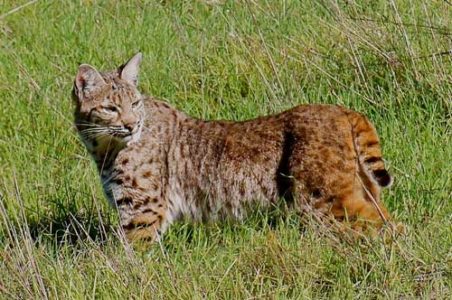
Lynn herself made a fascinating observation this week. She spotted a bobcat walking toward a doe in the field downhill from Mitchell cabin.
To Lynn’s surprise, the deer didn’t flee. Instead, the doe rose on her hind legs facing the bobcat and kicked at it with her front feet. The bobcat lumbered off.
We see several deer around Mitchell cabin every day, but bobcats only occasionally. This one, however, left a calling card: a small pile of scat by our front steps.

____________________________________________________________________________________
Lynn and I scatter birdseed morning and evening on our front deck’s railings and benches.

The birds enthusiastically consume most of the seed, but inevitably leave a bit behind.

Roof rats just as inevitably show up to finish off the leftovers. Here four rats gobble down what the birds left behind.

When rats show up before all the birds have left, the two manage to get along fairly well.
They’re called “roof rats” because the species likes to hang out near the tops of buildings. Our roof rats never get higher than the basement, and we’ve killed off those that got that far.
However, they also crawl inside Lynn’s car where they’ve gnawned through wiring and even gnawed their way into her glove compartment where they chew on road maps and other papers. In an effort to keeps them out of the car she sprays peppermint oil around their entry points. To some degree that helps, but it leaves the car smelling like a candy bar.
_______________________________________________________________________________
And now for some real humor, I’ll look to Jimmy Niro’s book Dad Jokes.
What did the cook say to the dough? I knead you.
I just finished my first day of excavation training. So far I’m really digging it.
You never see penguins in Great Britain because they’re afraid of Wales.
What did Tennessee? The same thing Arkansas.
Wed 2 Jun 2021
Posted by DavidMitchell under Uncategorized
Comments Off on Thistles, tall grass, and swallows
Caveat lectorem: When readers submit comments, they are asked if they want to receive an email alert with a link to new postings on this blog. A number of people have said they do. Thank you. The link is created the moment a posting goes online. Readers who find their way here through that link can see an updated version by simply clicking on the headline above the posting.

Italian thistles in our field.
A clump of thistles in a field outside Mitchell cabin ambushed me this week. I tripped over one and fell into the clump. It was so painful I told myself, “I need Jesus’ help. He’s rescued me before.”
So I called Jesus Macias and asked him to bring his tractor mower and weed-whacking brethren over next week to chop the thistles. They’ll all be here Monday.

Cut thistles in May,/ They’ll grow in a day;/ Cut them in June,/ That is too soon; Cut them in July,/ Then they will die. Mother Goose rhyme.
Mother Goose rhymes were, of course, originally penned 300 years ago in the more-northern latitudes of England and France, where the growing season starts later. Thistles in West Marin need to be cut a month earlier.
Eleven years ago I published a posting titled the Mother Goose Method for Getting Rid of Thistles (click here to read), and to my surprise it continues to garner readers every year, making it one of my best read ever. Somehow people keep finding it.
However, I don’t know how much you can infer from that. The best-read posting by far on this blog is A Chat with the Trailside Killer (click here to read). which I also posted 11 years ago. The fact that mass murders continue to haunt this country may explain readers’ continued interest.

Blacktail doe hidden by tall grass. Important as it is to cut back our thistles it’s probably even more important that Jesus’ crew will be cutting the grass just ahead of the fire season.

A cliff swallow sits in mud nest it’s helping build.
Last week I wrote about the various creatures that sleep at Mitchell cabin. Now we’re adding another. A family of cliff swallows is building a nest above our kitchen door. It happens every year, and other swallows will probably soon build neighboring nests.
They’re fun to have around, but it’s always sad when one of the nests comes loose, falls off the wall, and shatters on our deck below. For now we’re being careful to avoid shutting the kitchen door hard enough to shake the nest.
Thu 27 May 2021
Posted by DavidMitchell under Uncategorized
Comments Off on The question is: where to sleep?
Caveat lectorem: When readers submit comments, they are asked if they want to receive an email alert with a link to new postings on this blog. A number of people have said they do. Thank you. The link is created the moment a posting goes online. Readers who find their way here through that link can see an updated version by simply clicking on the headline above the posting.
__________________________
This week we’ll take a look at who’s been sleeping around Mitchell cabin besides Lynn, me, and our previously stray cat Newy. These days it’s not just a matter of sheltering in place but also of finding shelter.

A tranquil doe. My wife Lynn found this blacktail deer sleeping on our front steps Tuesday morning. (Photo by Lynn Axelrod Mitchell)

Snoozing raccoon. Early Tuesday evening I was surprised to find this raccoon sleeping on our deck quite close to our front door.

Sleeping place invaded. A short while later, another raccoon began snoozing a few feet from our kitchen door only to have two skunks show up to finish off the handfuls of kibble I’d given the raccoon. It appeared to pay only drowsy attention to the skunks and stayed put.

Two raccoons asleep on our front deck still later Tuesday evening. Mitchell cabin has obviously become a secure enough retreat that a variety of wildlife nap here.

Billy Hobbs (left). Aside from his hair on a windy day, Billy is not exactly wild, but he has been homeless for more than seven years since the breakup of a 25-year marriage.
When I first met Billy, an artist, he was living on the street in Point Reyes Station. After the weather got bad in the winter of 2019-20, Lynn and I offered to let him stay in our basement. Last year I let him sleep in my second car, which I parked on Mesa Road downtown, moving it every 72 hours to comply with the law.
At present, Billy, 63, is being sheltered at Motel 6 in San Rafael, with county government picking up the tab. Wednesday afternoon, his friend Gaspar drove Billy out to Point Reyes Station so he could visit his onetime hangouts. Thank God, Billy at least for the moment has a secure place to sleep. Society too often treats the homeless as if they were all wild animals.
Fri 29 May 2020
Posted by DavidMitchell under General News, Photography, Point Reyes Station, West Marin nature, Wildlife
Comments Off on Apocalypse later
Caveat lectorem: When readers submit comments, they are asked if they want to receive an email alert with a link to new postings on this blog. A number of people have said they do. Thank you. The link is created the moment a posting goes online. Readers who find their way here through that link can see an updated version by simply clicking on the headline above the posting.
The previously announced closing of the Station House Café this coming Monday has been postponed until after July 4, owner Sheryl Cahill said this week. It could stay open through September if revenue is keeping up with costs. Cahill dismayed West Marin three weeks ago when she said she would close at the end of May because new landlords planned to raise her $100,000 per year rent to $252,000, which she couldn’t afford.
For the next three months, however, her rent is frozen. Once she does close, Cahill hopes to find a new site, and landlord John Hural hopes to find a new restaurateur to rent his building.

This New York Times headline from 10 years ago still amuses me, for it implied that the Palestinian Authority considers indoor plumbing unacceptable in a Muslim country. As it turned out, Hamas was actually upset with women smoking hookahs.

A mother raccoon, who shows up outside our kitchen door every evening begging for kibble, brought four new kits with her the past two nights. They’re very cute and often climb the lattice to the railing but then have trouble climbing back down. They do it headfirst, so it’s a challenge.

Even more of a surprise was this blacktail doe who showed up on our lower deck two mornings ago and then went down some stairs to a still-lower level to inspect our hot tub. My wife Lynn already suspected that a deer had been venturing onto the lower deck at night because some buds in a flowerpot there were getting eaten. I was skeptical, but I guess she’s right.

A male red-winged blackbird repeatedly buzzes a raven drinking from our birdbath and eventually drives him away. Since ravens sometimes eat baby birds, the blackbirds don’t like ’em.
Mon 6 Feb 2012
 Last week I reported that a Guatemalan wife and mother of two, Cristina Siekavizza (at right), disappeared July 7.
Last week I reported that a Guatemalan wife and mother of two, Cristina Siekavizza (at right), disappeared July 7.
Authorities suspect she was murdered by her husband, Roberto Barreda de Leon, and that he has probably fled to the United States, taking the couple’s two children, Roberto Jose, 7, and Maria Mercedes, 4, with him.
As I wrote, I became interested in the case because my former wife Ana Carolina Monterroso is a friend of Cristina’s relatives. She and Cristina’s brother Pablo have notified me that roughly 25,000 people are currently using social media to track down Roberto.
I believe it. Last week’s posting drew a record 1,217 visitors in the first three days after it went online. Some 432 of those were in Guatemala. Readers have posted links to this blog on their Facebook pages and on other websites. Truly social media in action.

An international warrant for the English-speaking husband’s arrest has been issued. If people spot him, they should notify local law enforcement or the FBI. Please note that the email address in Guatemala for reporting his whereabouts is incorrect on the wanted poster. It should be busquedacristina@gmail.com.
 Point Reyes Station. Mitchell cabin with its red roof is near the center of the photo.
Point Reyes Station. Mitchell cabin with its red roof is near the center of the photo.

Around Mitchell cabin two foxes are making themselves more and more at home with every passing week. Lynn and I can hand feed them slices of bread although one is more skittish than the other. The first sits around the kitchen door waiting for me to hand it dinner. Usually we have to throw the slices to its partner.
 For a year or more we had been feeding our foxes and raccoons honey-roasted peanuts along with bread, but that became fairly expensive.
For a year or more we had been feeding our foxes and raccoons honey-roasted peanuts along with bread, but that became fairly expensive.
Our problem was solved by Gayanne Enquist of Inverness.
She recommended we forget about peanuts and feed our critters dog kibble. It was a brilliant idea.
Once we determined through experimentation which brand they prefer, Kibble and Bits, we could eliminate peanuts and most bread from their dinners.
However, the kibble is so popular that we might as well be feeding two large dogs.
Along with the foxes, we get five or six raccoons every night.
One raccoon is a solitary male. The others belong to two families that don’t like each other, so we have to put out two trays of kibble on the deck and keep refilling them.
That adds up to about 40 pounds of kibble per week.
The foxes wait their turn for the kibble until the raccoons leave although the raccoons are also a bit wary of the foxes.

Of course, we’re not always Johnny on the spot in setting out their dinners, and here a fox waits patiently while a raccoon approaches cautiously.

We also feed a variety of birds, including towhees, sparrows, doves, and scores of redwing blackbirds. They have a set feeding time, somewhere between 4:30 and 5 p.m. However, the birds aren’t the only beneficiaries of the birdseed. Roof rats, those cute little rodents, show up almost as soon as the blackbirds leave.

Blacktail deer are ubiquitous around Mitchell cabin. This year I’ve seen as many as 14 at one time. Here a fawn sleeps right outside our kitchen window while two does graze nearby.
The deer are so comfortable around us that I can often approach them within a few feet.
Although we’re in the middle of winter, these are great days to relax. Just keep your eyes out for a murder suspect fleeing Guatemala.
Tue 10 Jan 2012
 Hosting our wildlife neighbors. My girlfriend Lynn Axelrod is a reporter for The West Marin Citizen, which for the past two weeks has been publishing its annual pet issues. She and I don’t have any pets ourselves because they would drive away birds and four-footed wildlife, but in recent years I too have sometimes published an animal issue at the beginning of the new year.
Hosting our wildlife neighbors. My girlfriend Lynn Axelrod is a reporter for The West Marin Citizen, which for the past two weeks has been publishing its annual pet issues. She and I don’t have any pets ourselves because they would drive away birds and four-footed wildlife, but in recent years I too have sometimes published an animal issue at the beginning of the new year.
 Among the most common wildlife around Mitchell cabin these days are wild turkeys, and last weekend, they began showing up on the railing around our deck. Here one marches past our dining-room window.
Among the most common wildlife around Mitchell cabin these days are wild turkeys, and last weekend, they began showing up on the railing around our deck. Here one marches past our dining-room window.

Wild turkeys can be aggressive, and a decade or more ago, they began chasing and otherwise terrorizing school children in Tomales. This young deer, however, was not at all intimidated when it found itself grazing among a flock of turkeys between Mitchell cabin and neighbors Dan and Mary Huntsman’s home last Sunday.

A turkey stares at me from behind a lamp hanging over our dining-room table.

A mother raccoon (at rear) introduces her four kits to our kitchen.

A bobcat hunting just uphill from the cabin.

A gray fox on our deck.

This possum didn’t mind being petted as long as I gave it something to eat.

A coyote in the field below Mitchell cabin two weeks ago.
 A mother badger and her cub as seen from my field.
A mother badger and her cub as seen from my field.

One of my favorite wildlife photos, which I’ve published before, is of a buckeye butterfly on a chrysanthemum. The plant was growing in a pot on my deck.
Sun 25 Dec 2011
Two close friends from Los Angeles, Janine Warner, who reported for The Point Reyes Light when I owned the newspaper, and her husband Dave LaFontaine, have been staying here for the Christmas holidays.
On Christmas Day itself, however, some even more exotic guests showed up.
 Around noon Janine went out on the deck to enjoy the sunny Christmas Day and soon spotted a coyote in my field. Here it heads into some eponymous coyote brush.
Around noon Janine went out on the deck to enjoy the sunny Christmas Day and soon spotted a coyote in my field. Here it heads into some eponymous coyote brush.
 Immediately I hurried inside and grabbed my camera. Before long, the coyote reemerged next to my parking area. It could hear us chattering on the deck and began staring at me while I took its picture.
Immediately I hurried inside and grabbed my camera. Before long, the coyote reemerged next to my parking area. It could hear us chattering on the deck and began staring at me while I took its picture.
 The creature then looked down my driveway to make sure all was clear. Coyotes can be fierce, but they’re not foolhardy.
The creature then looked down my driveway to make sure all was clear. Coyotes can be fierce, but they’re not foolhardy.
 When it finally decided to leave, it started off at a brisk walk. Whether walking or running, coyotes are amazingly graceful.
When it finally decided to leave, it started off at a brisk walk. Whether walking or running, coyotes are amazingly graceful.

Coyotes have a walking speed that sometimes tops 20 mph while their running speed can easily top 30 mph. This coyote, however, was just meandering. It took him almost half a minute to travel 0.2 miles to the bottom end of the driveway, where he then sat down to survey the area. Before long, he had disappeared without a trace.

Less than five minutes later, as if on cue, two bucks showed up outside our kitchen window. Both were good looking animals, but the buck in the foreground had an especially regal bearing.

Accompanying the bucks were two does. Like the bucks, the does were not particularly nervous, even when I went out the back door to get a clear photo of them.
Of course, these were not the only wild animals to visit Mitchell cabin on Christmas Day. Our familiar raccoon families showed up in the evening. We fed them slices of bread, but, to save money, we’re now supplementing that with dog kibble instead of honey-roasted peanuts.
Also showing up were our usual pair of gray foxes. One is comfortable enough around us to take slices of bread from our hands. The other, however, is sufficiently skittish that most of the time we have to throw slices to him.
Having a peaceful relationship with the animals around us is key to our having a decent existence, as most religions agree. “Life is dear to the mute creature as it is to a man. Just as one wants happiness and fears pain, just as one wants to live and not to die, so do other creatures,” wrote the XIV Dalai Lama in 1967.
“There is not an animal on the earth, nor a flying creature on two wings, but they are people like unto you,” proclaims the Qur’an. “Animals, as part of God’s creation, have rights which must be respected,” Dr. Donald Coggan, the former Archbishop of Canterbury, observed. “It behooves us always to be sensitive to their needs and to the reality of their pain.”


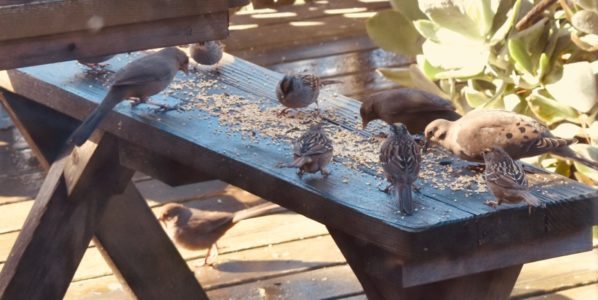
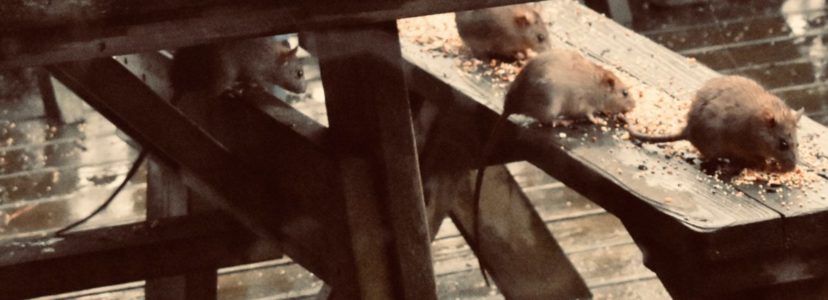
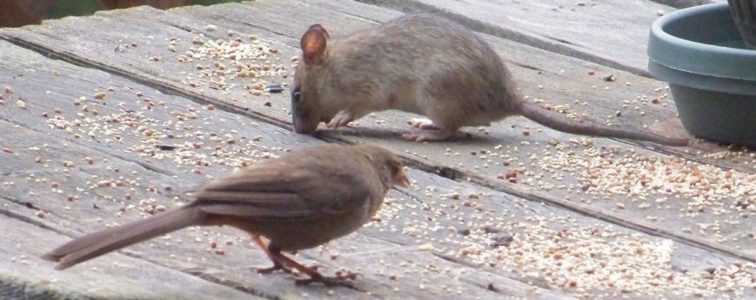

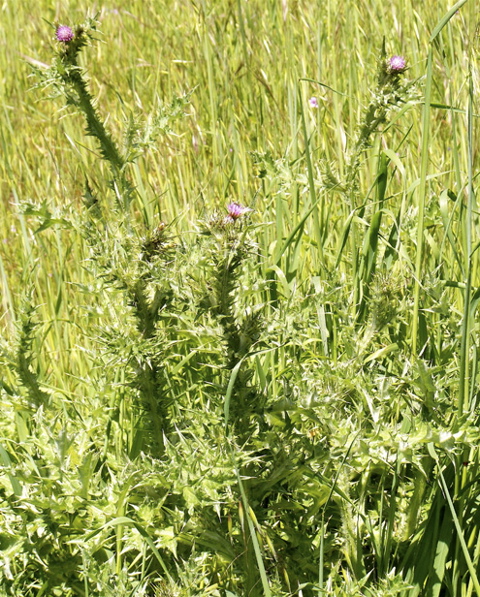
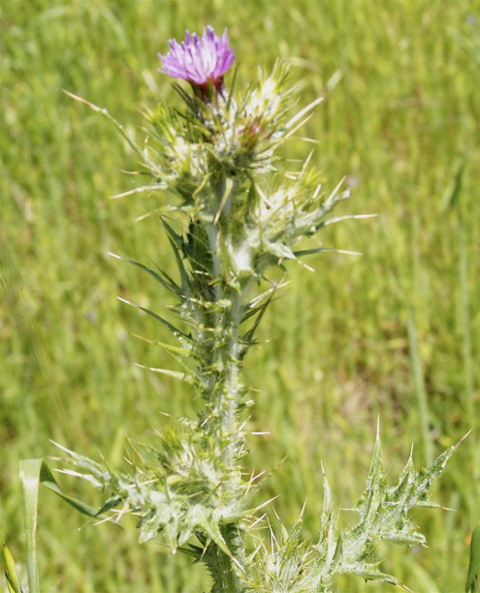
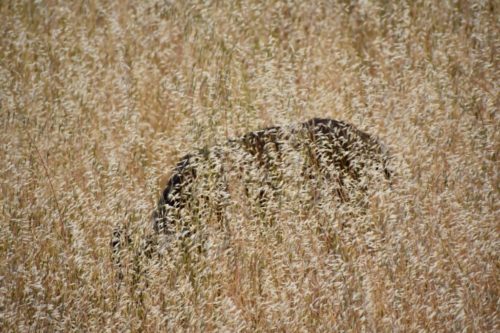
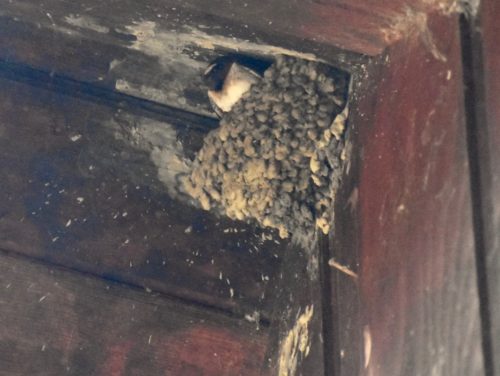
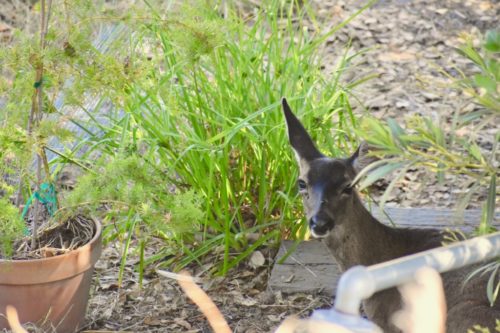
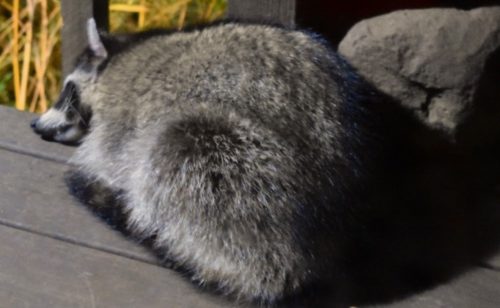
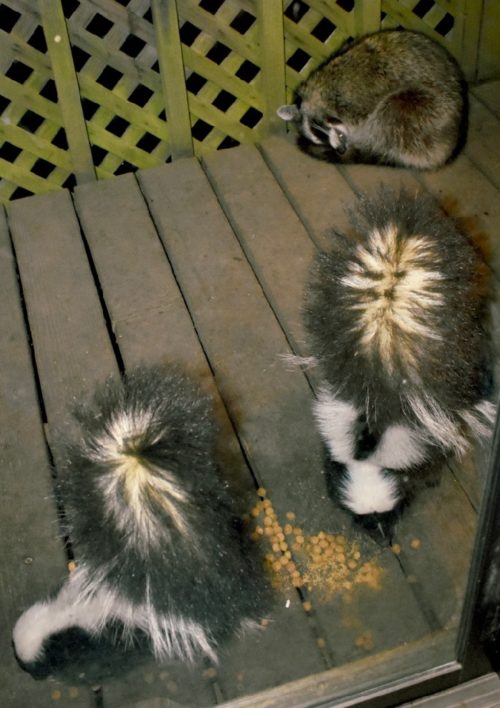
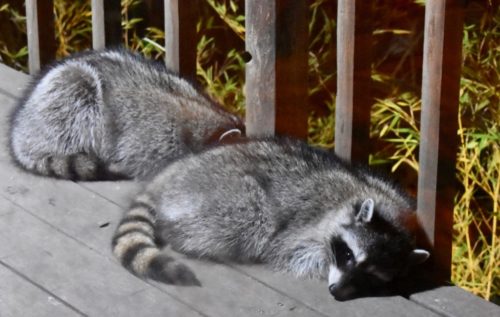


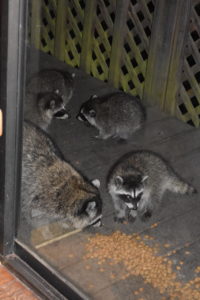
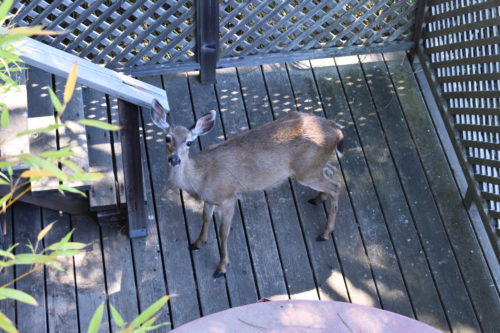
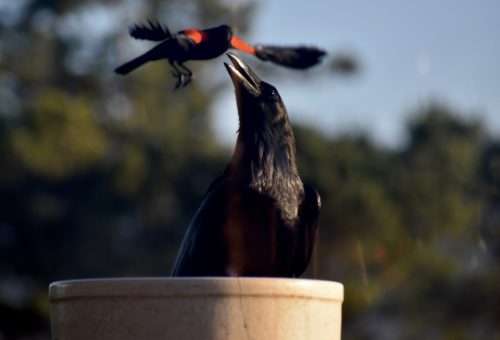



















 Around noon Janine went out on the deck to enjoy the sunny Christmas Day and soon spotted a coyote in my field. Here it heads into some eponymous coyote brush.
Around noon Janine went out on the deck to enjoy the sunny Christmas Day and soon spotted a coyote in my field. Here it heads into some eponymous coyote brush.




